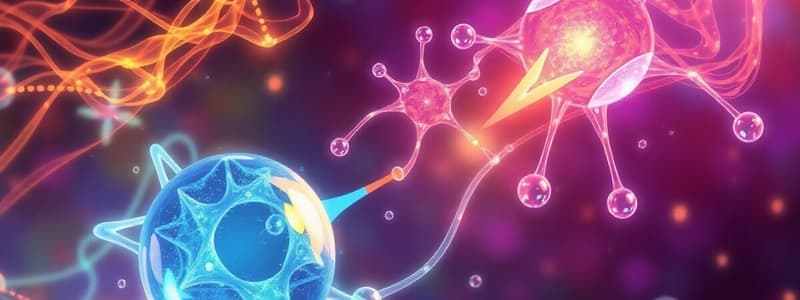Podcast
Questions and Answers
What is the balanced reaction when Iron (III) chloride reacts with sodium hydroxide?
What is the balanced reaction when Iron (III) chloride reacts with sodium hydroxide?
- FeCl3 (aq) + NaOH (aq) ==> Fe(OH)3 (s) + NaCl (aq)
- FeCl3 (aq) + 2NaOH (aq) ==> Fe(OH)3 (s) + 2NaCl (aq)
- FeCl3 (aq) + 4NaOH (aq) ==> Fe(OH)3 (s) + 4NaCl (aq)
- FeCl3 (aq) + 3NaOH (aq) ==> Fe(OH)3 (s) + 3NaCl (aq) (correct)
What is the correct name for FeBr2?
What is the correct name for FeBr2?
- iron (III) bromide
- ferric bromide
- iron (II) bromide (correct)
- ferrous bromide
What is the formula for sodium phosphate when sodium ion (Na+) and phosphate ion (PO4-3) combine?
What is the formula for sodium phosphate when sodium ion (Na+) and phosphate ion (PO4-3) combine?
- Na4PO3
- NaPO4
- Na2PO4
- Na3PO4 (correct)
How should the formula of Lead (IV) phosphate be written?
How should the formula of Lead (IV) phosphate be written?
For the compound formed from NH4+ and N3-, which formula is correct?
For the compound formed from NH4+ and N3-, which formula is correct?
What is the typical behavior of ionic compounds when dissolved in water?
What is the typical behavior of ionic compounds when dissolved in water?
Which of the following correctly names the negative ion formed from nitrogen?
Which of the following correctly names the negative ion formed from nitrogen?
How are the formulas of ionic compounds determined?
How are the formulas of ionic compounds determined?
Which of the following pairs forms the ionic compound represented by the formula NaF?
Which of the following pairs forms the ionic compound represented by the formula NaF?
Which of the following ions is always +2 in charge?
Which of the following ions is always +2 in charge?
What is the formula for the ionic compound that forms from Ba2+ and Cl-?
What is the formula for the ionic compound that forms from Ba2+ and Cl-?
What happens to the endings of negative ions when naming them?
What happens to the endings of negative ions when naming them?
Which of the following is a polyatomic ion?
Which of the following is a polyatomic ion?
What is the correct formula for the ionic compound formed by Na+ and S2-?
What is the correct formula for the ionic compound formed by Na+ and S2-?
Using the drop and swap method, what is the formula for Aluminum Oxide?
Using the drop and swap method, what is the formula for Aluminum Oxide?
Which formula correctly represents Magnesium Hydroxide?
Which formula correctly represents Magnesium Hydroxide?
What is the final formula for Calcium Phosphate after applying the drop and swap method?
What is the final formula for Calcium Phosphate after applying the drop and swap method?
Using the drop and swap method, what is the correct formula for Magnesium Oxide?
Using the drop and swap method, what is the correct formula for Magnesium Oxide?
What is the correct formula for Ammonium Chloride?
What is the correct formula for Ammonium Chloride?
After applying the drop and swap method, what is the formula for Calcium Sulfate?
After applying the drop and swap method, what is the formula for Calcium Sulfate?
What is the final balanced formula for the ionic compound formed from NH4+ and PO4-3?
What is the final balanced formula for the ionic compound formed from NH4+ and PO4-3?
What is the correct name for the compound KBr?
What is the correct name for the compound KBr?
How should the compound FeCl3 be correctly named?
How should the compound FeCl3 be correctly named?
What is the required information to name transition metals with variable charges?
What is the required information to name transition metals with variable charges?
Which of the following compounds contains iron with a +2 charge?
Which of the following compounds contains iron with a +2 charge?
Which of the following is the correct name for Al2O3?
Which of the following is the correct name for Al2O3?
For which of these compounds must a Roman numeral be used in its name?
For which of these compounds must a Roman numeral be used in its name?
What is the correct name for the ion Cu+?
What is the correct name for the ion Cu+?
What type of bond is formed between the ions in NaCl?
What type of bond is formed between the ions in NaCl?
Flashcards
Ionic Compounds
Ionic Compounds
Ionic compounds are formed by the electrostatic attraction between positively charged ions (cations) and negatively charged ions (anions). They are usually solid at room temperature and have a characteristic crystal lattice structure.
Salts
Salts
Ionic compounds are also known as salts. They are typically hard and brittle, meaning they break easily under pressure.
Conductivity of Ionic Compounds
Conductivity of Ionic Compounds
Ionic compounds conduct electricity when in a molten state or dissolved in a solvent. This is because the ions are free to move and carry electrical charge.
Melting and Boiling Point
Melting and Boiling Point
Signup and view all the flashcards
Solubility of Ionic Compounds
Solubility of Ionic Compounds
Signup and view all the flashcards
Predicting Charges on Monatomic Ions
Predicting Charges on Monatomic Ions
Signup and view all the flashcards
Naming Positive Ions
Naming Positive Ions
Signup and view all the flashcards
Naming Negative Ions
Naming Negative Ions
Signup and view all the flashcards
Balancing Chemical Equations
Balancing Chemical Equations
Signup and view all the flashcards
Single Replacement Reaction
Single Replacement Reaction
Signup and view all the flashcards
Combination Reaction
Combination Reaction
Signup and view all the flashcards
Decomposition Reaction
Decomposition Reaction
Signup and view all the flashcards
Double Replacement Reaction
Double Replacement Reaction
Signup and view all the flashcards
Charge Balance in Ionic Compounds
Charge Balance in Ionic Compounds
Signup and view all the flashcards
Ion Order in Formula
Ion Order in Formula
Signup and view all the flashcards
Subscripts in Ionic Formulas
Subscripts in Ionic Formulas
Signup and view all the flashcards
Drop and Swap Method
Drop and Swap Method
Signup and view all the flashcards
Simplest Whole Number Ratio
Simplest Whole Number Ratio
Signup and view all the flashcards
Naming Ionic Compounds
Naming Ionic Compounds
Signup and view all the flashcards
Naming Binary Ionic Compounds
Naming Binary Ionic Compounds
Signup and view all the flashcards
Naming Compounds with Polyatomic Ions
Naming Compounds with Polyatomic Ions
Signup and view all the flashcards
Transition Metals and Roman Numerals
Transition Metals and Roman Numerals
Signup and view all the flashcards
Metals with Fixed Charges
Metals with Fixed Charges
Signup and view all the flashcards
Understanding Roman Numerals
Understanding Roman Numerals
Signup and view all the flashcards
Naming Compounds with Transition Metals
Naming Compounds with Transition Metals
Signup and view all the flashcards
Example: Iron(III) Chloride
Example: Iron(III) Chloride
Signup and view all the flashcards
Example: Copper(I) Chloride
Example: Copper(I) Chloride
Signup and view all the flashcards
Roman Numerals and Specific Ions
Roman Numerals and Specific Ions
Signup and view all the flashcards
Alternative Names for Iron Compounds
Alternative Names for Iron Compounds
Signup and view all the flashcards
Alternative Names for Copper Compounds
Alternative Names for Copper Compounds
Signup and view all the flashcards
Study Notes
Ionic Compounds
- Ionic compounds are also known as salts.
- They are typically hard and brittle.
- They conduct electricity when molten or dissolved.
- Ionic compounds have very high melting and boiling points.
- Most ionic compounds are soluble in water.
- They are usually composed of at least one metal and one nonmetal.
Monatomic Ions
- A table lists common simple cations and anions, including their formulas and names.
- Examples: Hydrogen (H+), lithium (Li+), sodium (Na+), potassium (K+), cesium (Cs+), Beryllium (Be2+), Magnesium (Mg2+), Calcium (Ca2+), Barium (Ba2+), Aluminum (Al3+), and Silver (Ag+).
- Examples: Hydride (H-), fluoride (F-), chloride (Cl-), bromide (Br-), iodide (I-), oxide (O-), sulfide (S2-).
Predicting Charges on Monatomic Ions
- A periodic table diagram shows the common charges for monatomic ions.
- Metals generally form cations.
- Nonmetals generally form anions.
- The charges of elements are displayed according to their group number on the periodic table
- The general rule for predicting the charge of a metal or a nonmetal is known as the octet rule.
Naming Positive Ions
- To name a positive ion, use the element's name. For most elements, group 1, group 2, aluminum, zinc, cadmium, and silver, the numerical charge isn't shown.
- Examples: Sodium, magnesium, aluminum, zinc, cadmium, and silver.
Naming Negative Ions
- The ending of negative ions is changed to "-ide".
- Examples: Oxide, fluoride, chloride, bromide, iodide, nitride, and chloride.
Polyatomic Ions
- A table lists common polyatomic ions, including their formulas and names.
- Examples: Acetate (C₂H₃O₂⁻), Carbonate (CO₃²⁻), Chlorate (ClO₃⁻), Cyanide (CN⁻), Hydroxide (OH⁻), Nitrate (NO₃⁻), Nitrite (NO₂⁻), Peroxide (O₂²⁻), Phosphate (PO₄³⁻), Sulfate (SO₄²⁻), Sulfite (SO₃²⁻), and Ammonium (NH₄⁺).
Formulas of Ionic Compounds
- The formula of an ionic compound is determined by balancing the charges of the cation(s) and anion(s).
- The numbers are written as subscripts in the ionic compound formula.
- The total positive charge balances the total negative charge.
- Examples:
- Sodium fluoride (NaF: 1+ and 1-)
- Aluminum oxide (Al₂O₃: 3+ and 2- )
- Calcium chloride (CaCl₂: 2+ and 1-).
Writing Formulas for Ionic Compounds
- The formulas for ionic compounds can be written by balancing the charges of the ions.
Balancing Formulas by Math
- Every ionic compound has a total charge of zero.
- Examples: Barium fluoride (BaF₂) and Magnesium oxide (MgO)
Another Way — Drop, Swap, Reduce
- A method to find the formula of an ionic compound, balancing the positive and negative charges:
- "Drop and swap" method means write the number of the positive ion charge as the number of the negative ion and viceversa.
- Reduce to lowest terms
- Examples: Aluminum oxide (Al₂O₃), Magnesium oxide (MgO), Magnesium hydroxide (Mg(OH)₂), Calcium sulfate (CaSO₄), calcium phosphate (Ca₃(PO₄)₂), ammonium phosphate ((NH₄)₃PO₄) , ammonium chloride (NH₄Cl).
Transition Metals
- Transition metals can have multiple positive charges, thus require numbers in parenthesis to indicate the numerical charge: Roman Numerals
- Transition metal elements are usually found in Groups 3 through 12 of the periodic table.
- Examples: iron (Fe), copper(Cu), cobalt (Co), Manganese (Mn) can have +2 or +3 or even more numerical charge.
Names of Variable Ions
- Elements that need roman numerals to name them, because they can have more than one possible charge.
Transition Metals with Different Charges
- Elements with multiple possible charges (like iron, copper, cobalt, and manganese) require Roman numerals in their names.
- Examples: Iron (II) chloride and Iron (III) chloride
- Examples showing cupric (2+) and cuprous (1+) charges for copper and their formulas.
A Typical Exam Question
- Balancing a chemical equation demonstrating the reaction between iron(II) chloride (or iron (III) chloride) and sodium hydroxide to form iron(II) or iron(III) hydroxide and sodium chloride.
Learning Check
- Questions in tables that show formulas of ionic compounds and to identify the correct formula to specific elements and charges.
Naming Compounds
- To name binary ionic compounds, use the cation first (positive ion), then the anion (negative ion).
- Give the name of the metal (e.g., calcium).
- Add "-ide" to the root name of the nonmetal (e.g., chloride).
- Examples showing formulas and names of binary ionic compounds: NaCl, ZnI2, Al2O3, etc
Learning Check
- Compound name questions
- Using appropriate nomenclature rules to identify the naming scheme for the compounds given
Studying That Suits You
Use AI to generate personalized quizzes and flashcards to suit your learning preferences.



